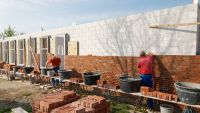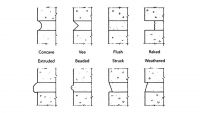The Art and Science of Testing: A Vital Part of the Cleaning Process
By Lynn Peden
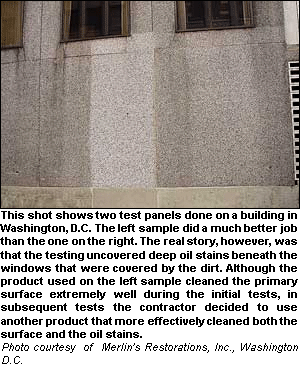 You've got a good chance at a big job. All that's left is to complete a "cookie cutter" demonstration like you've done many times before using your normal cleaner and process. This time, though, it's not working, and you don't know why. The job is lost, and the only option is to call the chemical manufacturer and complain about their product not working.
You've got a good chance at a big job. All that's left is to complete a "cookie cutter" demonstration like you've done many times before using your normal cleaner and process. This time, though, it's not working, and you don't know why. The job is lost, and the only option is to call the chemical manufacturer and complain about their product not working.
Perhaps nothing is more frustrating for a contractor than to lose or shut down a job because of what is perceived to be ineffective chemistry. Yet, more often than not, the problem isn't with the chemical itself. Rather, the issue is usually associated with using the wrong chemistry to solve the problem or the chemical's performance being hampered by any one of a number of variable conditions. It may even be a case of an inappropriate chemical being specified by the substrate manufacturer.
The answer to avoiding a situation like this is simple: testing. Testing is usually done on major projects but can be overlooked, particularly on small- or medium-sized ones. Testing is important because identifying the right solution can be a complex process since a variety of factors can create a virtually unlimited number of potential problems.
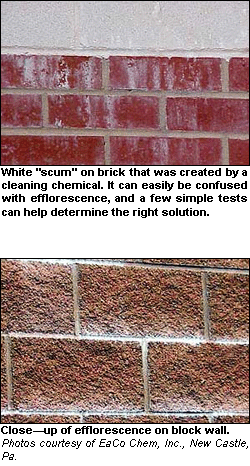 In some cases, you may need multiple solutions to correct a problem. A good example is our process for removing calcite. Generally, we recommend spot treating with calcite remover followed by an application of our new masonry detergent. The calcite remover softens the calcite while the masonry detergent removes it completely and ensures that the face of the substrate will appear uniform and without streaks.
In some cases, you may need multiple solutions to correct a problem. A good example is our process for removing calcite. Generally, we recommend spot treating with calcite remover followed by an application of our new masonry detergent. The calcite remover softens the calcite while the masonry detergent removes it completely and ensures that the face of the substrate will appear uniform and without streaks.
In addition, on projects where a color sensitive substrate or mortar is being cleaned and color bleed may be a concern, we recommend using another mildly acidic soap solution instead of the new masonry detergent in order to achieve the surface uniformity while protecting against color bleed.
In this instance, if you were to clean the building only with the calcite remover or new masonry detergent, chances are you would be unhappy with the results. More than likely, this would mean a phone call to the manufacturer complaining that the product didn't provide the desired finish when, in fact, the product did exactly what it was supposed to do.
Another common problem is misdiagnosing a stain, which we often see with efflorescence. For example, recently we received a call from a contractor who said his company was having trouble removing efflorescence from a brick wall. Since the job site was nearby, I decided to do an onsite inspection and test. After several unsuccessful attempts to remove the efflorescence, I finally realized that what we were trying to remove wasn't efflorescence but a much harder deposit commonly referred to as "white scum." We then switched to a product that we knew was more effective at softening the harder deposit and resolved the problem.
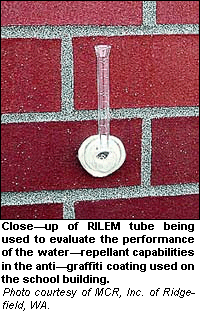 Again, in situations like this, we are likely to get a call complaining that the chemistry isn't working. In reality, the problem wasn't bad chemistry, it was just a case of a wrong diagnosis. These two compounds, while looking similar, are actually quite different chemical compounds and require different chemical solutions to dissolve those compounds. As this example shows, testing can be a great way to properly diagnose a problem.
Again, in situations like this, we are likely to get a call complaining that the chemistry isn't working. In reality, the problem wasn't bad chemistry, it was just a case of a wrong diagnosis. These two compounds, while looking similar, are actually quite different chemical compounds and require different chemical solutions to dissolve those compounds. As this example shows, testing can be a great way to properly diagnose a problem.
Testing can also help determine important information like the best dilution rate for a particular situation. Recently, on a trip to the West Coast, I visited a school site in Washington whose contractor had run into a problem with an anti-graffiti coating. Apparently, the brick exterior was still retaining moisture from rainfall several days earlier. Due to the moisture, the anti-graffiti coating wasn't being fully absorbed into the brick, and the excess was drying in several spots as an unsightly white haze.
After testing several products and dilutions, the contractor arrived at a solution that removed only the excess coating while retaining the integrity of the coating's sealant properties. This was verified by a RILEM test, which is used to evaluate the volume of water absorbtion by masonry during a specific period of time. An impatient contractor may have decided to just forgo any testing, opting instead to just restrip and reseal the the entire building at their own expense. What a mistake that would have been in this case!
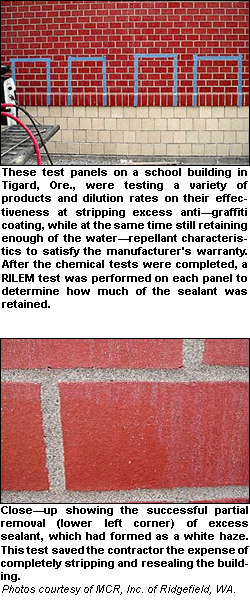 There are other issues that can arise as well. For example, a solution that may be effective on the East Coast may not work well on the West Coast or vice versa due to climate differences. Slight modifications in the cleaning process, chemistry selection or dilutions may be needed to accommodate any change in climate.
There are other issues that can arise as well. For example, a solution that may be effective on the East Coast may not work well on the West Coast or vice versa due to climate differences. Slight modifications in the cleaning process, chemistry selection or dilutions may be needed to accommodate any change in climate.
Our company offers a variety of inexpensive test kits that can help contractors avoid the hassles of shutting down a job due to unsatisfactory results. We recommend doing test patches, even for the most obvious of situations. What may appear to be a simple job cleaning a block wall can become a much more complex and expensive project if you suddenly discover an unseen sealant was previously used on it.
Another problem that testing can help overcome is reducing damage to nearby or secondary substrates. Several years ago, we were called to a job site in New Orleans where a terra cotta hotel was being restored. The hotel's inner courtyard was constructed of very porous St. Joseph's brick that had suffered from severe atmospheric staining. The contractors had tried 13 different test panels and, unfortunately, none of them proved to be effective in removing the stains. We sent down one of our products that was designed specifically for glazed surfaces. The product was tested on both the terra cotta and the St. Joseph's brick and worked very effectively. In addition, it was also tested to see if it would etch the building's 100-year-old hand-floated antique windows. Again, there were no problems.
The point of this example is that not only is it important to test different products to find the right solution to clean a particular substrate, but it's equally important to test the selected product on the other substrates it may come in contact with during the cleaning process.
The benefits of testing are numerous. It allows you to collect a wide variety of information before the project starts, including:
? The right product and process for removing the stain ? different chemistry may provide different levels of success;
? Any problems that may occur with nearby substrates that the chemistry may come in contact with during the cleaning process;
? Whether or not there are any "hidden" elements, such as coatings or sealants, that may inhibit a chemical's performance;
? The appropriate dilution levels and dwell times necessary for maximum effectiveness; and
? How much chemistry will be needed to complete the project.
Like most chemical companies, we follow strict quality standards about the products we manufacture, and instances of ineffective products are extremely rare. More often, other factors ? like those mentioned previously ? can impact the effectiveness of a chemical's performance. We believe it's worth the time and minimal expense to perform tests before a project starts in order to avoid major headaches down the road.
Cleaning and restoring masonry involves equal parts of "science" and "art." The chemicals you select will fulfill the "science" part of the equation; the "art" or skill part is up to you. Proper testing will help you improve that part and, when combined with the right chemistry and application process, will allow you to maximize profits, reduce liability costs and increase productivity.
Influencing a Chemical's Effectiveness
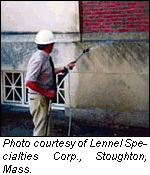 Testing is a means for evaluating the impact of a number of conditions that all play a critical role in determining the effectiveness of any chemical's ability to lift and remove a stain. Without adequately assessing each of these factors, the potential for problems ? or worse, failure ? is much greater. Among these factors are:
Testing is a means for evaluating the impact of a number of conditions that all play a critical role in determining the effectiveness of any chemical's ability to lift and remove a stain. Without adequately assessing each of these factors, the potential for problems ? or worse, failure ? is much greater. Among these factors are:
- The intensity of the stain and how deeply it has penetrated the substrate;
- The type of substrate itself and its porosity;
- The condition of the substrate (Was it cleaned previously? Is the surface burned? Was it sealed?);
- Dwell times;
- The dilution levels of the chemical;
- The geographical region and climate;
- The weather conditions (temperature, humidity, etc.) on the day the cleaning will take place; and
- The application process itself (i.e. brushing vs. spraying).
About the Author
Lynn Peden is president of EaCo Chem, Inc., a leader in developing safe, highly effective and powerful brushless cleaning solutions for the masonry, restoration, construction and transportation industries. For more information, call 800-313-8505 or visit EaCo Chem's web site at www.eacochem.com.













